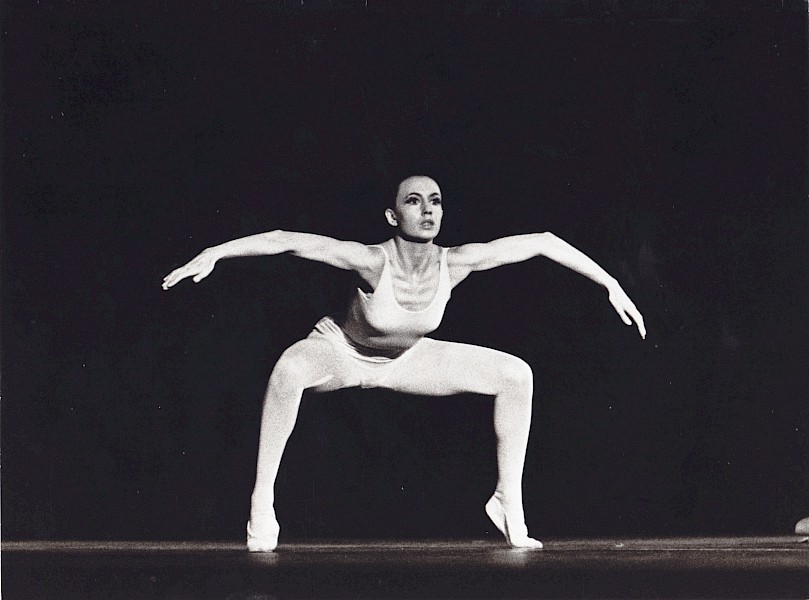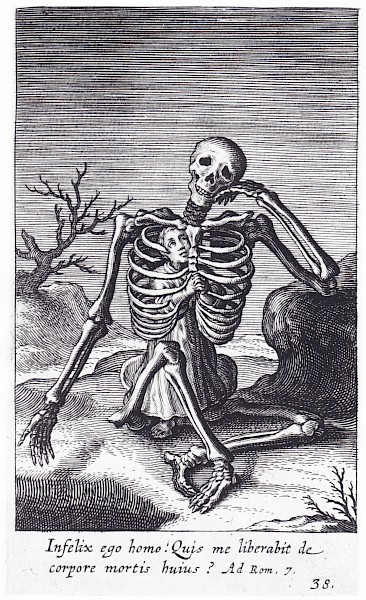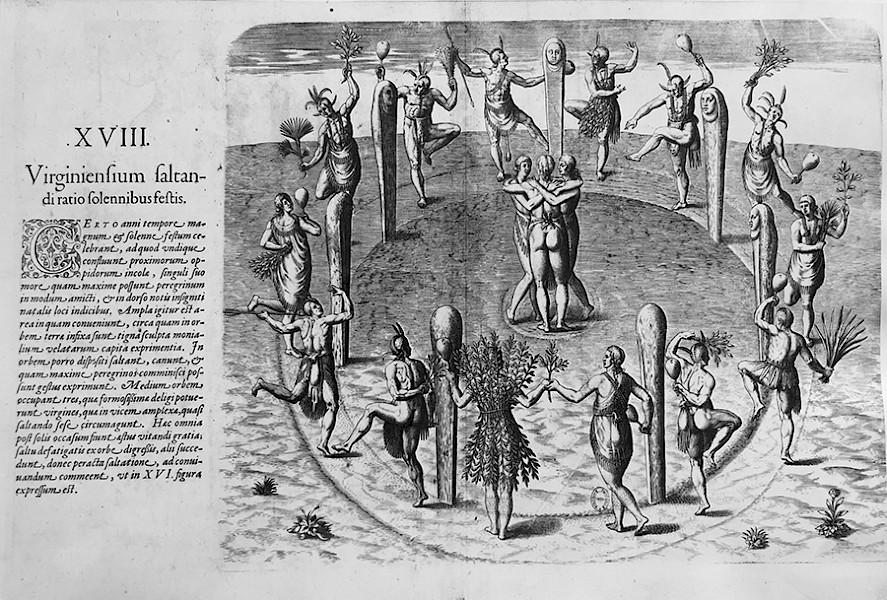Opening the Construction site of Dogmatic Structures …
Suddenly : Dance
Intrigued, fascinated by the changing states of the human body, by painted faces, by the solemnity or the futility of costume, I snuck away from the ones who reason like severed heads, old Greek expression still to ponder. Too close perhaps to peasants’ familiar clinching with animals, I used to be surprised at the indifference towards expressions such as body of text, body of wine, social body, constituent bodies, etc.
Where does this attitude towards the word “body” come from, thought I at the time, as linked first with medicine, then enriched of theological considerations through exegesis of the Incarnation of the divinity, and finally closeted by the 17th Century”s baroque pietism. Consider the iconography of Hermann Hugo from 1624 … anticipating the puritan legalism’s prima facie interpretations of the bourgeois 19th century. Viewing it closer up, as a psychoanalytic approach informed by clinical practice and the history of myth invites us, the theme of the “body-as-tomb of the soul” - one might as well say of desire - notifies to man the “remember” that you are mortal.
This reminder of an unrecognized essential enlarges our inquiry: whence comes that the stuff of flesh and blood designed by this lexical item, the body, has become a metaphor that has indefinitely been multiplied? Could it be that in these semantic transfers lie the vestiges of a primitive approach of the universe, to socialize it, to give it human form through way of speech?
For a long time I have asked myself: why has the phenomenon of a writing connection to self and to the world through the dancing body – choreographic systems as diverse as languages – been so crucial to my development, initially somewhat groping, towards a renewed anthropology? The answer came to me as an after-thought from a remark gleaned from the musicologist Curt Sachs: “Dance is the first of the arts. Before confiding his emotions to rocks, to word, to sound, man makes use of the body to organize space and to give rhythm to time.”
Before facing the crossings that psychoanalysis on this terrain renders possible, I had received memorable lessons from Africa, precisely through dance, which emphasized, in my representations of destiny, the marking of Western humanity by the distinction body/spirit, which came from the most remote of European civilization.
The result was that the absence of serious social reflection upon the status of the signifier ‘body’ came to seem to me less foreign, while a necessity for novel erudition loomed : the study of choreographic textuality. This means to consider dance for what it is: the silent discourse of the staged body.
Bit by bit this transhumance of the word “body” came to light, migrating and coming back to its original site, a to-and-fro between the subjective and the social scene through which institutional montages live and reproduce. . If these reflections are taken further, questioning from the observation that society itself, as it is carried by speech, is itself a Text, the horizon clarifies: all Tradition forms, decomposes and recomposes as a sedimentary Text, as a palimpsest.
Generations succeed one another but the theatre of words in which the actors are grammatical fictions lives on. From this perspective, investigations in all fields -be they Fiduciary (let us abandon the worn term “religion”), political, legal, calls for a know-how-to-interpret that be at the level required, a hermeneutic which embraces the historial of a civilization.
On the way, taking up again an ostracized vocabulary (dogma, dogmatic, dogmaticity), we rediscover what humanity has always known and which opens up for us the understanding of the species’ path of access to the institution of Reason: the theatrical condition of the speaking animal. Understanding the formation of Traditions is the necessary luggage to confront the strangeness of choreography, indissociable from its universal foundation..
A first breathing space, prior to taking the leap towards this study, had been my visiting the medieval and the people of the Renaissance : theologians of the mystic Body, liturgists who invoked the music of the spheres, poet readers of an Eucharistic Zodiac … Returning to the canonists and conscious of the aversion of my contemporaries to the medieval glossators and the demands of my method, I engaged, away from the 1968 Paris, in the society of international scholars questioning the sources of political and juridical sacrality (Stephan Kuttner, Ernst Kantorowicz, Gaines Post …)
Remembering the active kindness of my black Masters, I undertook then to open up the vast construction site of dogmatic structures, by unifying the traditional legalism of Europe where the (for me) enigmatic prohibition of dance had flowered, and which also harbored a treasury of indicative information about pagan peoples – Men of the forest, the savages (a word formed from the Latin silva, meaning forest)- and the practices of the instituting the body elaborated in the course of Western modernity.
The encounter with mediator-poems, by Mallarmé, by Valéry, these two thinkers of dance, and my book of standards-transgression, published under the title The Desire to be Another (La Passion d’être un autre), were the decisive moments of my enterprise. Lacan welcomed the book, with its precise subtitle, A Study of Dance, without word or curse, into his collection, even if his school, mired in a totalitarian conformism, pouted. It was in the circles of young dancers and choreographers, with the cineaste Jean Rouch and with the specialist in prehistory, André Leroi-Gourhan, that I received – how should I put it? – the equivalent of solace…
We still know too little about dance. It belongs to the shadowy domain of our origins, to that distant space we call prehistory, where the speaking animal entered into reflexive consciousness, confronting in dread a materiality dematerialized by language.
Under the empire of necessity, his own body and the world were alike uninhabitable by man without the mediation of a general theatricalization, which is to say that they had to be staged, reconstructed as fictions, through the mediation of images and words.
Going further than Curt Sachs, I propose the following: if the world has been capable of becoming mankind’s captive, and man prisoner of the world, if the relation man/world gained the status of an interlocution through the bond of identity/alterity, this pivoting was made possible by the first tool of survival: the invention of ceremonial procedures that allow thought to emerge primarily in a sensual mode – or, put differently, in an aesthetic fashion.
One clarification, to grasp the breadth of the field opened up by the study of dogmatic structures, in which is inscribed the phenomenon of dances.
Whilst the West speaks of writing, of scripture, as a way of referencing what is literally, “chore”- -“graphy”, I observed that this reference to the power to write corporeally, as signifying another second body created by the movements of the physical body, tends to blurr as soon as the object to take into consideration is the science of dancing bodies, which is foreign to our own system of representation. The European problematization of dance as writing hesitates to venture into these exotic Heterotopias (Elsewheres) in which the ceremonies of choreographic alienation are performed differently.
We are the descendants of man body and soul, of a bundle of formulations around an antique and christianized theme that situates man in Nature: the biped without wings, unable to fly except on the day of his death when the soul rejoins Heaven.
This ‘naturalist’ definition weighed on popular fears, mingled with hatred towards those who attempted to build machines that could fly, deemed as the work of Satan. Leonardo da Vinci, in his own way a transgressor, echoes this when, as a genius handyman, he announces aviation: “the great bird will take to the sky, filling the Universe with amazement”.
Under a Modernity free of prohibition, the act of dancing assumes the status of a poetic metamorphosis. Dogmatician comparatism illuminates the fact that dance in the West is thought of as an uprooting from the ground, a taking flight, and not, as in other African and Asian traditions, where dance proceeds sometimes from the rhythmic stamp of the ground, sometimes from a gymnastic sculpting of the body, in relation with representations, themselves specific, of the dialogue between man and world. And in these Elsewheres, music in solidarity with dance favor other instrumental forms including, for instance, the personalized voice of drums …



Translated by Peter Goodrich, with the collaboration of Cécile Korn